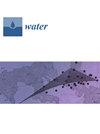干旱地区碳酸盐含水层的水力和水文地质化学特征:埃及西部沙漠案例
IF 3
3区 环境科学与生态学
Q2 ENVIRONMENTAL SCIENCES
引用次数: 0
摘要
利用来自 80 口地下水井的地球化学和抽水试验数据,对位于埃及西部沙漠 Al-Minya 区以西的断裂始新世碳酸盐含水层的化学、水文和水力特性进行了描述和确定,以确保在大规模沙漠开垦项目中对地下水资源进行可持续管理。水化学数据显示,来自断裂的始新世碳酸盐含水层的地下水具有较高的 Na+ 和 Cl- 浓度,盐度从 2176 毫克/升到 2912 毫克/升(咸水)不等。水与岩石的相互作用和离子交换过程是控制地下水成分的最主要过程。碳酸盐含水层存在于封闭到半封闭条件下,地下水深度向东增加。根据水位数据,深层断层是富含气体的水从深层努比亚含水层系统上升到上覆浅层碳酸盐含水层的途径。这一机制促进了碳酸盐岩的溶解和岩溶化,尤其是在断层附近,钻井过程中泥浆循环的大量流失也证明了这一点。根据阶梯式降水、长时间抽水和回采试验分析得出的平均估计水力参数表明,始新世碳酸盐岩含水层的渗透率(T)范围很宽,介于 336.39 至 389,309.0 之间。39 至 389,309.28 平方米/日(平均值:18,405.21 平方米/日)之间,导水性(K)在 1.31 至 1420.84 平方米/日(平均值:70.29 平方米/日)之间,比容(Sc)在 44.4 至 17,376.24 平方米/日(平均值:45.24 平方米/日)之间。另一方面,钻井的性能特征显示,油井效率在 0.47 至 97.08% 之间,油井损失在 2.92 至 99.53% 之间。除了碳酸盐含水层厚度和粘土/页岩含量的变化外,始新世碳酸盐含水层中存在的强烈岩溶化特征,即裂隙、裂缝或溶洞,也是造成 K 值和 T 值变化的原因。观测到的高井损可能与在导电断裂带钻井内部和附近的湍流有关。目前的方法可进一步用于加强当地含水层模型,并改进战略,以确定类似含水层系统中最具生产力的区域。本文章由计算机程序翻译,如有差异,请以英文原文为准。
Hydraulic and Hydrogeochemical Characterization of Carbonate Aquifers in Arid Regions: A Case from the Western Desert, Egypt
Using geochemical and pumping test data from 80 groundwater wells, the chemical, hydrologic, and hydraulic properties of the fractured Eocene carbonate aquifer located west of the Al-Minya district, the Western Desert, Egypt, have been characterized and determined to guarantee sustainable management of groundwater resources under large-scale desert reclamation projects. The hydrochemical data show that groundwater from the fractured Eocene carbonate aquifer has a high concentration of Na+ and Cl− and varies in salinity from 2176 to 2912 mg/L (brackish water). Water–rock interaction and ion exchange processes are the most dominant processes controlling groundwater composition. The carbonate aquifer exists under confined to semi-confined conditions, and the depth to groundwater increases eastward. From the potentiometric head data, deep-seated faults are the suggested pathways for gas-rich water ascending from the deep Nubian aquifer system into the overlying shallow carbonate aquifer. This mechanism enhances the dissolution and karstification of carbonate rocks, especially in the vicinity of faulted sites, and is supported by the significant loss of mud circulation during well drilling operations. The average estimated hydraulic parameters, based on the analysis of step-drawdown, long-duration pumping and recovery tests, indicate that the Eocene carbonate aquifer has a wide range of transmissivity (T) that is between 336.39 and 389,309.28 m2/d (average: 18,405.21 m2/d), hydraulic conductivity (K) between 1.31 and 1420.84 m/d (average: 70.29 m/d), and specific capacity (Sc) between 44.4 and 17,376.24 m2/d (average: 45.24 m2/d). On the other hand, the performance characteristics of drilled wells show that well efficiency ranges between 0.47 and 97.08%, and well losses range between 2.92 and 99.53%. In addition to variations in carbonate aquifer thickness and clay/shale content, the existence of strong karstification features, i.e., fissures, fractures or caverns, and solution cavities, in the Eocene carbonate aquifer are responsible for variability in the K and T values. The observed high well losses might be related to turbulent flow within and adjacent to the wells drilled in conductive fracture zones. The current approach can be further used to enhance local aquifer models and improve strategies for identifying the most productive zones in similar aquifer systems.
求助全文
通过发布文献求助,成功后即可免费获取论文全文。
去求助
来源期刊

Water
WATER RESOURCES-
CiteScore
5.80
自引率
14.70%
发文量
3491
审稿时长
19.85 days
期刊介绍:
Water (ISSN 2073-4441) is an international and cross-disciplinary scholarly journal covering all aspects of water including water science and technology, and the hydrology, ecology and management of water resources. It publishes regular research papers, critical reviews and short communications, and there is no restriction on the length of the papers. Our aim is to encourage scientists to publish their experimental and theoretical research in as much detail as possible. Full experimental and/or methodical details must be provided for research articles. Computed data or files regarding the full details of the experimental procedure, if unable to be published in a normal way, can be deposited as supplementary material.
 求助内容:
求助内容: 应助结果提醒方式:
应助结果提醒方式:


